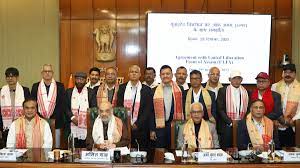- A memorandum of settlement was signed by the Union Ministry of Home Affairs (MHA), the Assam government, and the pro-talks side of the United Liberation Front of Asom (ULFA).
- This “tripartite settlement is significant for Assam’s peace,” according to the government, who claims to have succeeded in removing all violent groups in the state.
Assam’s and ULFA’s Struggle
- The United Liberation Front of Asom (ULFA) was founded in 1979 by radical thinkers in response to growing worries about the identity and resources of the indigenous Assamese population.
- Cultural and Economic Transitions: The flood of migrants caused by the expanding tea, coal, and oil industries, combined with the Partition and refugee influx, heightened concerns among local Assamese.
- The Assam Agreement of 1985: Aimed at resolving the issue of foreigners in Assam, the Accord was a response to a prolonged mass movement but failed to address all concerns, leading to the formation of ULFA.
Four Decades of Violence and the State’s Reaction
- Armed Struggle of the ULFA: Through armed warfare, the group sought a sovereign Assamese nation, resulting in kidnappings, extortion, and loss of life.
- In response, the Indian government launched Operation Bajrang in 1990, imposing President’s rule as well as the Armed Forces Special Powers Act (AFSPA) in Assam.
- Internal Divisions and Allegations from the State: Internal squabbles arose within the ULFA, with one faction (SULFA) surrendering and allegedly carrying out state-sponsored’secret executions’ of other ULFA members.
ULFA’s External Support and Links
- Camps in Neighbouring Countries for External Support and Links: ULFA established camps in Myanmar, Bangladesh, and Bhutan, using them for training, housing, and the launch of cross-border operations.
- Connections with Global Terrorist Organisations: The group formed ties with Islamic terror organisations and Pakistan’s ISI, with its military chief reportedly meeting Osama Bin Laden.
- Initial Peace Talks: In 2005, the ULFA organised a ‘People’s Consultative Group’ for peace talks, but discussions fell through, leading to further violence.
- Renewed Peace Efforts: Following 2008, several ULFA commanders, particularly Arabinda Rajkhowa, pursued peace talks, resulting in a serious schism within the organisation.
- Demands of the Pro-Talks side: In 2012, the pro-talks side submitted a 12-point charter of demands, resulting in current conversations and the historic tripartite peace deal.
Tripartite Peace Treaty
- The accord reached by the pro-talks ULFA side, the administration of India, and the Assam state administration is a crucial step towards peace.
- Opinions of Experts: Journalists and specialists like Rajeev Bhattacharya see the agreement as a welcome step forward, but they are sceptical about its completeness and usefulness.
- Optimism in the Government: The Union Home Minister voiced trust in the accord as ushering in a new era of peace, while the Assam Chief Minister expressed interest in engaging with the anti-talks side.
Source: https://indianexpress.com/article/explained/explained-politics/ulfa-peace-accord-history-of-its-44-year-long-insurgency-peace-talks-9088017/


One reply on “The ULFA Story and the Historic Tripartite Agreement”
I have read some excellent stuff here Definitely value bookmarking for revisiting I wonder how much effort you put to make the sort of excellent informative website